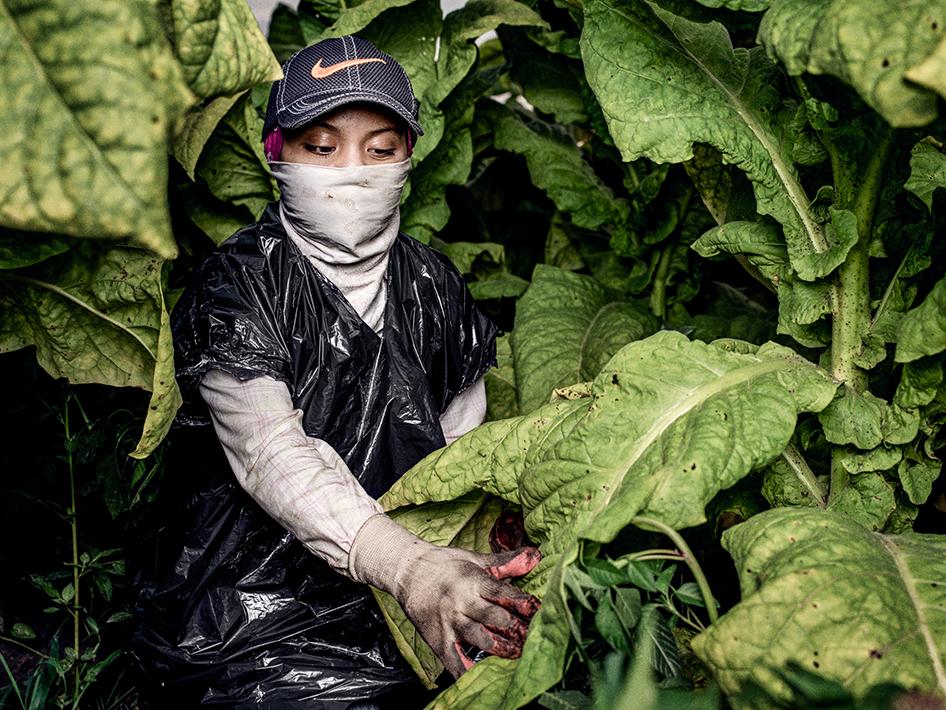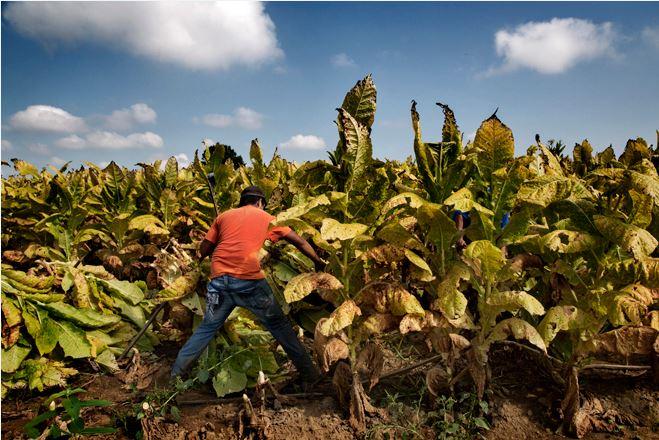Tobacco harvester — A five-most-dangerous job for teens
A 12-year-old cannot legally buy cigarettes in the U.S., but they are allowed to work in a tobacco field for 10- to 12- hours a day in 100-degree heat and suffer repeated bouts of nicotine poisoning. This is legal because of decades-old exemptions to U.S. child labor laws that apply to agriculture. Teen tobacco workers do not die at the highest rate, but they do feel as if they are dying in large numbers.

A Human Rights Watch (HRW) report, “Tobacco’s Hidden Children: Hazardous Child Labor in United States Tobacco Farming,” published in May 2014 found that three quarters of 141 child tobacco workers interviewed in North Carolina, Kentucky, Virginia and Tennessee—the main tobacco-producing states—reported getting sick while working on U.S. tobacco farms. Many of their symptoms—nausea, vomiting, loss of appetite, headaches, and dizziness—are consistent with acute nicotine poisoning (also known as “Green Tobacco Sickness”.) A frequent comment from child tobacco workers who experience this illness is, “I thought I was going to die.”
Child tobacco workers often use dangerous, sharp tools and can work in tobacco drying barns at heights without protective equipment as they balance precariously on the top of wood beams that may be only one or two inches thick.
In addition to nicotine, farmworker children may also be absorbing a range of toxic pesticides commonly used in tobacco fields. Children often wear black garbage bags to protect them from these dual exposures but you can imagine what it’s like to wear a plastic bag in the 90- and 100-degree temperatures often found in tobacco fields.
To make matters worse, Human Rights Watch found that three of the four states that produce 90 percent of US tobacco (Kentucky, Virginia, and Tennessee) have failed to take sufficient measures to enforce the Occupational Safety and Health Administration’s (OSHA) Field Sanitation Standard. This standard requires workers to be provided with fresh drinking water, hand washing facilities, and toilets. Most of the children interviewed by HRW were not provided with hand washing facilities or toilets, and some were not given sufficient drinking water. The absence of hand washing facilities significantly increases the risks of nicotine and pesticide exposure.
Using information from the OSHA Integrated Management Information System, HRW reports that from January 2010 to December 2013: Kentucky carried out only eight field inspections in tobacco; Tennessee carried out one field inspection; and Virginia carried out none. Only one of the four major tobacco-producing states, North Carolina, made meaningful attempts to enforce the Field Sanitation Standard, with 143 inspections during the time period, said HRW researchers.
The situation, with children as young as 12 (and HRW found about a dozen kids conducting lighter work in the fields who were under 12), is so absurd that it proved to be great material for the satirists at “The Daily Show with Jon Stewart,” who produced an entertaining, but alarming, report called “Nicoteens.” The clip is comical and allows you to hear young tobacco workers describing the work conditions in their own words, but child labor in U.S. tobacco is not funny. It’s embarrassing.
We share here the words of a 14-year-old girl who worked in tobacco fields (from an HRW interview) and suffered nicotine poisoning:
“My head started hurting, and I kind of felt like throwing up.” [The tobacco plants were dripping wet from dew and rain, and her clothes got soaked while she worked in fields.] “I just go home in my wet clothes.”
In 2011, the Obama Administration acted to implement regulations to protect working children from farm dangers, including tobacco work, but those rules were withdrawn in 2012 because of opposition from the farm community, and it appeared to NCL, fears that the controversial rules might cost Senate seats. Child Labor Coalition (CLC) members fought hard for those comprehensive protections, but health and safety advocates were no match for the resources of the agricultural lobby.
The wholesale withdrawal of occupational child safety regulations for farms left child workers in tobacco vulnerable to nicotine poisoning, pesticide poisoning, and other dangers. It’s time to fix this glaring consequence of the Administration’s complete pullback—it’s abdication of its responsibilities to protect children—and move forward to protect children in tobacco fields. In August 2014, the CLC sent President Obama a letter signed by 50 groups, representing millions of Americans, asking him to take action, but the President has been silent.
Congress is trying to respond with the “Children Don’t Belong on Tobacco Farms” bill in both the House (HR 1848) and Senate (S 974) that would ban child labor in U.S. tobacco. NCL joined the Child Labor Coalition, which it co-chairs, and 56 other organizations to urge members of Congress to support the legislation in an open letter to Congress in May 2015.
NCL continues to wonder why the Obama Administration is not doing more to deal with the problem of children performing this hazardous work. Earlier this year, the Occupational Safety and Health Administration released a recommended practices bulletin with guidance on reducing the hazards for tobacco workers. The U.S. Department of Labor (DOL) convened a meeting with several NGOs including NCL, CLC, and 16 members of the tobacco industry to discuss responses to the problem of children working in tobacco fields. So far, however, the Administration has taken no significant steps to protect children working in tobacco fields.
Several tobacco companies and two grower associations have acknowledged the danger of this work and its inappropriateness for young workers. The tobacco companies have implemented policies to prohibit the growers they use from hiring children under 16. The 2015 harvest was the first year that the new rules were applied and it is unclear how well the new policies are working or if they are working at all. NCL and its Child Labor Coalition partners continue to advocate for a ban on all child work in tobacco because of its dangers.
In 2015, HRW issued a follow-up report, “Teens of the Tobacco Fields—Child Labor in United States Tobacco Farming” focusing on 16- and 17-year-old tobacco workers whose labor was not addressed by tobacco company policies and whose work, although dangerous, goes on because the U.S. government abandoned its attempt to designate the work as “hazardous.”
Human Rights Watch interviewed 26 children, ages 16 and 17, who worked on tobacco farms in North Carolina in 2015 and found:
“Almost all of the children interviewed—25 out of 26—said they experienced sickness, pain, and discomfort while working. Most children interviewed experienced the sudden onset of at least one specific symptom consistent with acute nicotine poisoning while working in tobacco farming in 2015, or after returning home from working in tobacco fields, including nausea, vomiting, headaches, dizziness, and lightheadedness.
Many children also reported either working in or near fields that were being sprayed with pesticides, or re-entering fields that had been sprayed very recently. A number of children reported immediate illness after coming into contact with pesticides.”

A young farmworker in the US during the tobacco harvest (photo courtesy of Human Rights Watch)

